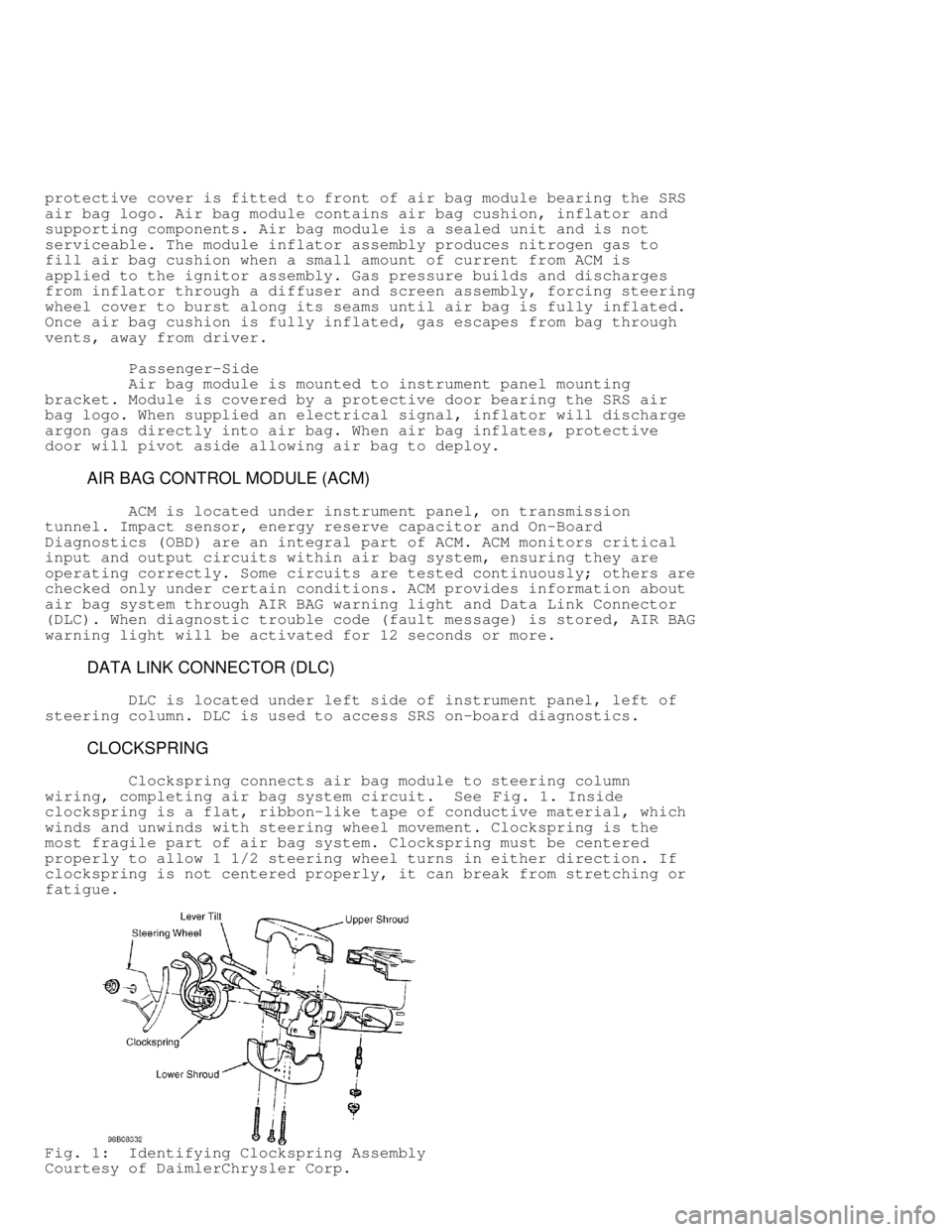transmission DODGE RAM 1999 Service Repair Manual
[x] Cancel search | Manufacturer: DODGE, Model Year: 1999, Model line: RAM, Model: DODGE RAM 1999Pages: 1691, PDF Size: 40.34 MB
Page 1 of 1691

ABBREVIATIONS
1999 Dodge Pickup R1500
GENERAL INFORMATION
COMMONLY USED ABBREVIATION
"A" ABBREVIATION TABLE
"A" ABBREVIATION TABLE
ABBREVIATION DEFINITION A Amperes A/C Air Conditioning A/T Automatic Transmission/Transaxle AAP Auxiliary Accelerator Pump AB Air Bleed ABCV Air Bleed Control Valve ABDC After Bottom Dead Center ABRS Air Bag Restraint System ABS Anti-Lock Brake System AC Alternating Current ACC A/C Clutch Compressor ACCS A/C Cycling Switch ACCUM Accumulator ACCY Accessory ACT Air Charge Temperature Sensor ACV Thermactor Air Control Valve ADJ Adjust or Adjustable ADV Advance AFS Airflow Sensor AI Air Injection AIR or A.I.R. Air Injection Reactor AIS Air Injection System ALCL Assembly Line Communications Link ALDL Assembly Line Diagnostic Link ARC Automatic ASCD Automatic ASCS Air Suction Control Solenoid ASD Auto Shutdown ASDM Air Bag System Diagnostic Module ASV Air Suction Valve ATC Automatic Temperature Control ATDC After Top Dead Center ATF Automatic Transmission Fluid ATS Air Temperature Sensor AXOD Automatic Transaxle Overdrive Abs. Absolute Accy. Accessory Alt. Alternator or Altitude Amp. Ampere Assy. Assembly Auto. Automatic Aux. Auxiliary Avg. Average
3
Page 7 of 1691

"M" ABBREVIATION TABLE
"M" ABBREVIATION TABLE
ABBREVIATION DEFINITION mA Milliamps mV Millivolts mfd. Microfarads Mm Millimeters M/T Manual Transaxle or Transmission MA PFI Mass MA or MAF Mass Airflow MAF Mass Air Flow Sensor MAFS Mass Airflow System MAP Manifold Absolute Pressure Sensor MAT Manifold Air Temperature MCU Microprocessor Control Unit MCV Mixture Control Valve MEM-CAL Memory Calibration Chip MFI Multiport Fuel Injection MIL Malfunction Incicator Light MLP Manual Lever Position MPFI Multi Point Fuel Injection MPH Miles Per Hour MPI Multi-Point (Fuel ) Injection Man. Manual Mech. Mechanical Mem. Memory Mtr. Motor
"N" ABBREVIATION TABLE
"N" ABBREVIATION TABLE
ABBREVIATION DEFINITION N.m Newton-Meter NA Not Available NDS Neutral Drive Switch NGS Neutral gear Switch NOx Oxides of Nitrogen NPS Neutral Pressure Switch No. Number Nos. Numbers
"O" ABBREVIATION TABLE
"O" ABBREVIATION TABLE
ABBREVIATION DEFINITION O Oxygen O.D. Outside Diameter O/S Oversize O2 Oxygen OC Oxidation Catalyst OCC Output Circuit Check OD Overdrive ODO Odometer
Page 10 of 1691

"T" ABBREVIATION TABLE
"T" ABBREVIATION TABLE
ABBREVIATION DEFINITION T.V. Throttle Valve _ TAB Thermactor Air By-Pass _ TAC Thermostatic Air Cleaner _ TAD Thermactor Air Diverter _ TAN Tan _ TBI Throttle Body Injection _ TCC Torque Converter Clutch _ TCCS Toyota Computer Control System TDC Top Dead Center _ TDCL Total Diagnostic Communication TFI Thick Film Ignition system _ TGS Top Gear Switch (cancels SIL in THERMAC Thermostatic Air Cleaner _ THS Transmission Hydraulic Switch _ TP/TPS Throttle Position Sensor _ TPI Tuned Port Injection _ TPS Throttle Position Sensor/Switch TS Temperature Sensor _ TSB Technical Service Bulletin _ TTS Transmission Temperature Switch TV Thermovalve _ TWC Three-Way Catalyst _ Temp. Temperature _ Trans. Transaxle/Transmission _
"V" ABBREVIATION TABLE
"V" ABBREVIATION TABLE
ABBREVIATION DEFINITION V Valve _ VAF Vane Air Flow sensor or circuit _ VAPS Variable Assist Power Steering _ VAT Vane Air Temperature _ VATS Vehicle Anti-Theft System _ VBATT Vehicle Battery Voltage _ VCC Viscous Converter Clutch _ VIN Vehicle Identification Number _ VIO Violet _ VLR Volt Loop Reserve _ VM Vacuum Modulator _ VM Vane Meter _ VOM Volt-Ohmmeter (Analog) _ VPWR Vehicle Power supply voltage (10-14 VREF Voltage Reference (ECA supplied ref VRV Vacuum Regulator Valve _ VSC Vehicle Speed Control sensor or sign VSS Vehicle Speed Sensor or signal _ VSV Vacuum Switching Valve _ Vac. Vacuum _ Volt. Voltage _
Page 54 of 1691

are continually republished. In addition to these, standards for Drive
Train and Transmissions have recently been promulgated. Participating
shops utilize these Uniform Inspection & Communication Standards as
part of the inspection process and for communicating their findings to
their customers.
The Motorist Assurance Program continues to work
cooperatively and proactively with government agencies and consumer
groups toward solutions that both benefit the customer and are
mutually acceptable to both regulators and industry. We maintain the
belief that industry must retain control over how we conduct our
business, and we must be viewed as part of the solution and not part
of the problem. Meetings with state and other government officials
(and their representatives), concerned with auto repair and/or
consumer protection, are conducted. Feedback from these sessions is
brought back to the association, and the program adjusted as needed.
To assure auto repair customers recourse if they were not
satisfied with a repair transaction, the Motorist Assurance Program
offers mediation and arbitration through MAP/BBB-CARE and other non-
profit organizations. MAP conducted pilot programs in twelve states
before announcing the program nationally in October, 1998. During the
pilots, participating repair shops demonstrated their adherence to the
Pledge and Standards and agreed to follow the UICS in communicating
the results of their inspection to their customers. To put some
"teeth" in the program, an accreditation requirement for shops was
initiated. The requirements are stringent, and a self-policing method
has been incorporated which includes the "mystery shopping" of
outlets.
We welcome you to join us as we continue our outreach... with
your support, both the automotive repair industry and your customers
will reap the benefits. Please visit MAP at our Internet site www.
motorist.org or contact us at:
1444 I Street, NW Suite 700
Washington, DC 20005
Phone (202) 712-9042 Fax (202) 216-9646
January 1999
MAP UNIFORM INSPECTION GENERAL GUIDELINES
OVERVIEW OF SERVICE REQUIREMENTS & SUGGESTIONS
It is MAP policy that all exhaust, brake, steering,
suspension, wheel alignment, drive-line, engine performance and
maintenance, and heating, ventilation and air conditioning, and
electrical services be offered and performed under the standards and
procedures specified in these sections.
Before any service is performed on a vehicle, an inspection
of the appropriate system must be performed. The results of this
inspection must be explained to the customer and documented on an
inspection form. The condition of the vehicle and its components will
indicate what services/part replacements may be "Required" or
"Suggested". In addition, suggestions may be made to satisfy the
requests expressed by the customer.
When a component is suggested or required to be repaired or
replaced, the decision to repair or replace must be made in the
customer's best interest, and at his or her choice given the options
available.
This section lists the various parts and conditions that
indicate a required or suggested service or part replacement.
Although this list is extensive, it is not fully inclusive. In
addition to this list, a technician may make a suggestion. However,
any suggestions must be based on substantial and informed experience,
Page 104 of 1691

assembly towards right side of vehicle and remove rear A/C-heater
assembly.
5) To install, reverse removal procedure. Ensure all wiring
and hoses are clear and not pinched. Tighten bolts and nuts to
specification. See TORQUE SPECIFICATIONS .
Removal (Ram Pickup - Front)
1) Disconnect negative battery cable. Drain cooling system.
In engine compartment, remove coolant hoses from heater core tubes.
Remove coolant overflow bottle.
2) Discharge A/C system, using approved refrigerant
recovery/recycling equipment. Disconnect refrigerant lines from
evaporator and plug or cover all openings in A/C system. Remove
instrument panel. See INSTRUMENT PANEL. Remove Powertrain Control
Module (PCM) and position aside. DO NOT disconnect 60-pin connector
from PCM.
3) Remove attaching nuts from studs on engine compartment
side of dash panel. Remove defrost duct. Disconnect electrical
connectors. Remove attaching nuts from studs in passenger compartment
side of dash panel. Remove A/C-heater assembly from vehicle. See
Fig. 5 .
4) Place A/C-heater assembly upside-down on work bench.
Remove screw securing floor duct to bottom of A/C-heater assembly and
slide floor duct off of center heat duct adapter. Unsnap center heat
duct adapter from bottom of A/C-heater assembly housing. Remove screw
hidden behind adapter. Remove remaining screws and separate A/C-heater
assembly.
Installation
Ensure mode door pivot pins are properly inserted in holes.
To complete installation, reverse removal procedure.
A/C-HEATER CONTROL PANEL R & I
Removal & Installation (Dakota & Durango)
1) Disconnect negative battery cable. On models equipped with
A/T, unlock ignition switch. Set parking brake and place gear selector
lever in "L" position. If equipped, set tilt steering column in lowest
position.
2) On all models, carefully pry bezel away from instrument
panel to disengage clips. Unplug connectors from cigarette lighter and
auxiliary power outlet. Disconnect fog light switch (if equipped).
Remove A/C-heater control panel screws.
3) Pull control panel outward enough to disconnect wiring
connector, vacuum harness, and temperature control cable. Remove A/C-
heater control panel. To install, reverse removal procedure. Adjust
temperature control cable. See TEMPERATURE CONTROL CABLE ADJUSTMENT .
Removal & Installation (Ram Pickup)
1) Disconnect negative battery cable. Reach under driver's
side of instrument panel, near transmission tunnel and unplug A/C-
heater control panel to A/C-heater assembly vacuum harness connector.
Disconnect vacuum harness from center air duct.
2) On models equipped with A/T, unlock ignition switch. Set
parking brake and place gear selector lever in "L" position. If
equipped, set tilt steering column in lowest position.
3) On all models, remove screw securing cluster bezel to
instrument panel. See Fig. 6. Carefully pry bezel away from instrument
panel to disengage clips. Unplug connectors from cigarette lighter and
auxiliary power outlet.
4) Remove 4 screws attaching A/C-heater control panel. Pull
control panel outward enough to disconnect wiring connector, vacuum
harness and temperature control cable. Remove A/C-heater control
Page 109 of 1691

6) Remove glove box. Reach through glove box opening and
disconnect antenna coaxial cable connector. Disconnect blower motor
connector located above glove box opening, near support brace for A/C-
heater housing. Disconnect radio ground strap. Loosen instrument panel
roll down bracket bolts about 2 turns, located at lower corners on
both sides of instrument panel. Remove 5 screws across top of dash
panel at base of windshield, removing center screw last.
7) Roll down instrument panel and install a temporary support
hook that is about 18" (457 mm) in length. Install hook from center
hole in instrument panel to center hole of dash panel. Pull lower
instrument panel outward until both roll down bracket bolts are in
slotted roll down position. Instrument panel should now be supported
and away from firewall.
8) Disconnect 2 door harness connectors, located on a bracket
near right end of instrument panel. Disconnect blower motor resistor.
Disconnect temperature control cable from A/C-heater housing and
remove from housing. See Fig. 5. Disconnect demister duct flexible
hose from A/C-heater housing.
9) Ensure instrument panel is free and clear for removal.
With the aid of an assistant, remove temporary support hook. Lift
instrument panel off of roll down bracket bolts and remove from
vehicle.
10) To install, reverse removal procedure. Ensure all wiring
and hoses are clear and not pinched. Tighten bolts and nuts to
specification. See TORQUE SPECIFICATIONS . Enable air bag system. See
AIR BAG SYSTEM SAFETY article.
Removal & Installation (Ram Pickup)
1) Disable air bag system. See AIR BAG SYSTEM SAFETY article.
Disconnect negative battery cable. Drain cooling system. Remove left
and right kick panel trim. Remove 5 screws and knee bolster/steering
column cover. Remove hood release and parking brake release handle
screws from lower instrument panel support. Remove 6 screws and
instrument panel support. Disconnect air bag connector at lower left
corner of instrument panel.
2) Pull PRNDL cable and twist to remove from position arm.
Push tab on bottom of cable retainer upward, then squeeze sides to
remove retainer from column. Remove tilt lever (tilt column only).
Remove both upper and lower shrouds from column. Remove lower fixed
column shroud. Loosen multifunction switch connector screw. Screw will
remain in connector.
3) Remove remaining steering column electrical connectors.
Remove air bag wiring harness from steering column wiring trough.
Remove wiring trough from steering column. Remove 3 toe plate nuts and
washers.
4) Remove 2 nuts and washers attaching steering column
bracket to instrument panel steering column support bracket. Allow
column to lower and rest on seat. Remove 2 screws from bottom of Air
Bag Control Module (ACM) cover. Remove 4 screws holding ACM to
transmission tunnel.
5) Disconnect wiring at ACM. Disconnect instrument panel left
side wiring connectors. Remove screw holding brake release to bottom
of instrument panel. Disconnect instrument panel right side wiring
connectors, which includes 2 connectors attached to A/C-heater
assembly housing, courtesy light connector, antenna cable and 2 body
connectors. Disconnect vacuum harness from A/C-heater system.
6) Remove 5 screws holding instrument panel to dash. Loosen
lower instrument panel pivot bolts. Roll instrument panel downward.
Remove instrument panel from vehicle.
7) To install, reverse removal procedure. Ensure all wiring
and hoses are clear and not pinched. Tighten bolts and nuts to
specification. See TORQUE SPECIFICATIONS . Enable air bag system. See
AIR BAG SYSTEM SAFETY article.
Page 174 of 1691

protective cover is fitted to front of air bag module bearing the SRS
air bag logo. Air bag module contains air bag cushion, inflator and
supporting components. Air bag module is a sealed unit and is not
serviceable. The module inflator assembly produces nitrogen gas to
fill air bag cushion when a small amount of current from ACM is
applied to the ignitor assembly. Gas pressure builds and discharges
from inflator through a diffuser and screen assembly, forcing steering
wheel cover to burst along its seams until air bag is fully inflated.
Once air bag cushion is fully inflated, gas escapes from bag through
vents, away from driver.
Passenger-Side
Air bag module is mounted to instrument panel mounting
bracket. Module is covered by a protective door bearing the SRS air
bag logo. When supplied an electrical signal, inflator will discharge
argon gas directly into air bag. When air bag inflates, protective
door will pivot aside allowing air bag to deploy.
AIR BAG CONTROL MODULE (ACM)
ACM is located under instrument panel, on transmission
tunnel. Impact sensor, energy reserve capacitor and On-Board
Diagnostics (OBD) are an integral part of ACM. ACM monitors critical
input and output circuits within air bag system, ensuring they are
operating correctly. Some circuits are tested continuously; others are
checked only under certain conditions. ACM provides information about
air bag system through AIR BAG warning light and Data Link Connector
(DLC). When diagnostic trouble code (fault message) is stored, AIR B\
AG
warning light will be activated for 12 seconds or more.
DATA LINK CONNECTOR (DLC)
DLC is located under left side of instrument panel, left of
steering column. DLC is used to access SRS on-board diagnostics.
CLOCKSPRING
Clockspring connects air bag module to steering column
wiring, completing air bag system circuit. See Fig. 1. Inside
clockspring is a flat, ribbon-like tape of conductive material, which
winds and unwinds with steering wheel movement. Clockspring is the
most fragile part of air bag system. Clockspring must be centered
properly to allow 1 1/2 steering wheel turns in either direction. If
clockspring is not centered properly, it can break from stretching or
fatigue.
Fig. 1: Identifying Clockspring Assembly
Courtesy of DaimlerChrysler Corp.
Page 178 of 1691

foot wires to terminals of a 12-volt battery. After air bag module
deploys, let module cool off and allow dust to settle before
approaching.
POST-COLLISION INSPECTION
When a vehicle has been involved in a collision, certain
components of the passive restraint system must be inspected or
replaced. See PASSIVE RESTRAINT SYSTEM INSPECTION article in the
GENERAL INFORMATION section for post-collision inspection information.
REMOVAL & INSTALLATION
* PLEASE READ THIS FIRST *
WARNING: Failure to follow air bag service precautions may
result in air bag deployment and personal injury. See
SERVICE PRECAUTIONS . After component replacement,
ensure proper system operation. See SYSTEM OPERATION CHECK.
CAUTION: When battery is disconnected, vehicle computer and memory
systems may lose memory data. Driveability problems may
exist until computer systems have completed a relearn cycle.
See COMPUTER RELEARN PROCEDURES in GENERAL INFORMATION
before disconnecting battery.
AIR BAG CONTROL MODULE (ACM)
WARNING: ACM contains impact sensor, which enables SRS to activate air
bag. To avoid accidental air bag deployment, DO NOT connect
ACM electrically to system unless it is bolted to vehicle.
Removal
1) Before proceeding, see SERVICE PRECAUTIONS. Disable air
bag system. See DISABLING & ACTIVATING AIR BAG SYSTEM . Remove bottom
of center console (ACM trim cover).
2) On M/T models, remove center console from floor panel
transmission tunnel. On A/T models, remove screws securing trim cover
to ACM mounting bracket. See Fig. 2. Pull top of trim cover rearward
to release snap clips from instrument panel support bracket.
3) On all models, loosen but do not remove screws on sides
that secure instrument panel support bracket to ACM mounting bracket.
See Fig. 3 .
4) Remove nuts securing support bracket to studs on lower
instrument panel. Disconnect wire harness retainer from hole in
support bracket. Pull top of support bracket away from instrument
panel studs and fold down over ACM until it is laying on floor panel.
Unplug wire harness connector from ACM.
CAUTION: Always replace ACM and ACM mounting bracket as an assembly.
Replacement ACM includes a NEW mounting bracket. DO NOT mount
NEW ACM to old mounting bracket.
5) Remove screws securing mounting bracket to floor panel
transmission tunnel. Remove ACM, mounting bracket and support bracket
as a unit from floor panel.
Installation
To complete installation, reverse removal procedure. Install
ACM with arrow pointing toward front of vehicle. Connect ACM
connectors, ensuring connectors are locked into position. Tighten ACM
Page 181 of 1691

damage clockspring and/or require clockspring to be
readjusted.
NOTE: Clockspring is self-centering and will automatically lock in
the centered position when steering wheel is removed.
Adjustment is only required if centering position is
disturbed.
Removal
1) Before proceeding, see SERVICE PRECAUTIONS. Disable air
bag system. See DISABLING & ACTIVATING AIR BAG SYSTEM .
2) Clockspring is located behind steering wheel. See Fig. 1.
Ensure front wheels are in straight-ahead position. Lock steering
wheel. Remove air bag module. See AIR BAG MODULE.
3) Remove steering wheel nut. Using appropriate steering
wheel puller, remove steering wheel. When steering wheel is removed,
self-centering clockspring will automatically lock in place. Remove
upper and lower steering column shrouds to gain access to clockspring
wiring.
4) Remove knee bolster (if equipped). Disconnect Yellow 2-wa\
y
clockspring harness connector between clockspring and instrument panel
wiring harness, at base of steering column. See Fig. 13. Remove
clockspring by releasing 2 tabs on side of clockspring. Clockspring
cannot be repaired and must be replaced if faulty.
Installation
1) Snap clockspring onto steering column. If clockspring
centering adjustment is disturbed, adjust clockspring before
installing steering wheel. See CLOCKSPRING CENTERING under
ADJUSTMENTS. Connect clockspring wiring connectors. Install steering
column covers. Install knee bolster (if removed).
2) Position steering wheel on steering column. Ensure flats
on steering wheel hub fit formations on inside of clockspring. Pull
clockspring, cruise control switch (if equipped) and horn wires
through lower large holes and upper small holes in steering wheel.
3) Install steering wheel retaining nut and tighten to 45 ft.
lbs. (61 N.m). Connect horn and cruise control wires (if equipped).
Connect clockspring wire to air bag module. To ensure complete
connector connection, latching arms must be visible on top of
connector housing. DO NOT connect negative battery cable at this time.
Go to SYSTEM OPERATION CHECK .
PASSENGER AIR BAG DISARM (PAD) SWITCH
Removal & Installation
1) Before proceeding, see SERVICE PRECAUTIONS. Disable air
bag system. See DISABLING & ACTIVATING AIR BAG SYSTEM .
2) If vehicle is equipped with automatic transmission, turn
ignition switch to UNLOCK position, set parking brake and place
transmission selector lever in LOW position. Tilt steering column to
lowest position (if equipped). Using trim stick, gently pry around
perimeter of cluster bezel and remove bezel.
3) Open glove box. Holding glove box door, push center of
glove box bin towards front of vehicle. Flex glove box bin far enough
so glove box stops will clear sides of instrument panel opening. Roll
glove box down until stop bumpers are beyond sides of instrument panel
opening. Release bin. Lift bottom of glove box upward to disengage
hinge hooks form hinge pins.
4) Reach through glove box opening to access and disconnect 2
passenger-side air bag disarm switch harness connectors. Connectors
are attached to bracket located on inboard glove box opening
reinforcement. See Fig. 4. Remove 3 screws retaining passenger-side
air bag disarm switch bezel to instrument panel.
Page 195 of 1691

NOTE: All active codes must be resolved before diagnosing store
codes.
1) Raise and support vehicle. Start engine and let idle with
transmission in PARK position. Wiggle wiring harness and connectors of
air bag system and rotate steering wheel from stop to stop.
2) Visually inspect related wire harness connectors. Look for
broken, bent, pushed out, spread, corroded or contaminated terminals.
Also, look for chafed, pierced, pinched or partially broken wires.
3) Check for trouble codes as you work through system. If
stored trouble code becomes active, perform appropriate diagnostic
test. If stored code is reproducible, repair or replace wiring
harness, harness connector or terminals or replace component as
necessary.
CLUSTER MESSAGE MISMATCH
NOTE: Perform AIR BAG VERIFICATION TEST after
all repairs. Each time a connector is disconnected, inspect
it to ensure it is in good condition. Always focus on circuit
being tested. Dirt, water and corrosion, are most common
problems in connectors. Due to manufacturer changes in wire
colors, use terminal identification whenever possible.
1) If AIR BAG warning light is on, go to next step. If AIR
BAG warning light is not on, go to step 5).
2) Using DRB, select PASSIVE RESTRAINTS, AIRBAG and MONITOR
DISPLAY. Read WARNING LAMP STATUS. If DRB does not display MIC LAMP
STATUS ON, replace instrument cluster. If DRB displays MIC LAMP STATUS
ON, go to next step.
3) If DRB displays ACM LAMP REQUEST: ON, go to next step. If
DRB does not display ACM LAMP REQUEST: ON, replace instrument cluster.
4) If there are no potential causes for this DTC remaining,
ACM is assumed to be defective. Replace ACM. See
AIR BAG CONTROL MODULE (ACM) under REMOVAL & INSTALLATION.
NOTE: If AIR BAG warning light is defective, instrument cluster
will flash seat belt light for 30 seconds starting 10 seconds
after bulb check stops.
5) Using DRB, read air bag control module active codes
(messages). If CLUSTER MISMATCH is only active message, go to next
step. If other messages are present, go to appropriate diagnostic test
to continue diagnosis.
6) If seat belt warning light flashes for 30 seconds after
bulb check is complete, replace instrument cluster. If seat belt
warning light does not flashes for 30 seconds after bulb check is
complete, go to next step.
7) Using DRB, select PASSIVE RESTRAINTS, AIRBAG and MONITOR
DISPLAY. Read WARNING LAMP STATUS. If DRB displays ACM LAMP REQUEST:
OFF, go to next step. If DRB does not display ACM LAMP REQUEST: OFF,
replace instrument cluster.
8) If DRB displays MIC LAMP REQUEST: OFF, go to next step. If
DRB does not display MIC LAMP REQUEST: OFF, replace instrument
cluster.
9) If there are no potential causes for this DTC remaining,
ACM is assumed to be defective. Replace ACM. See
AIR BAG CONTROL MODULE (ACM) under REMOVAL & INSTALLATION.
DRIVER SQUIB CIRCUIT OPEN
NOTE: Perform AIR BAG VERIFICATION TEST after
all repairs. Each time a connector is disconnected, inspect